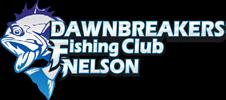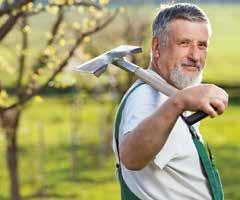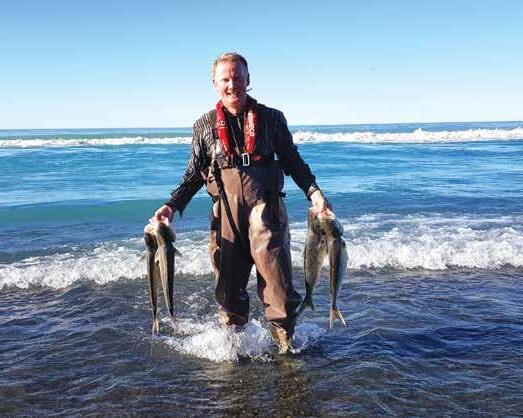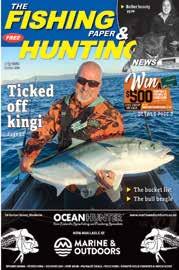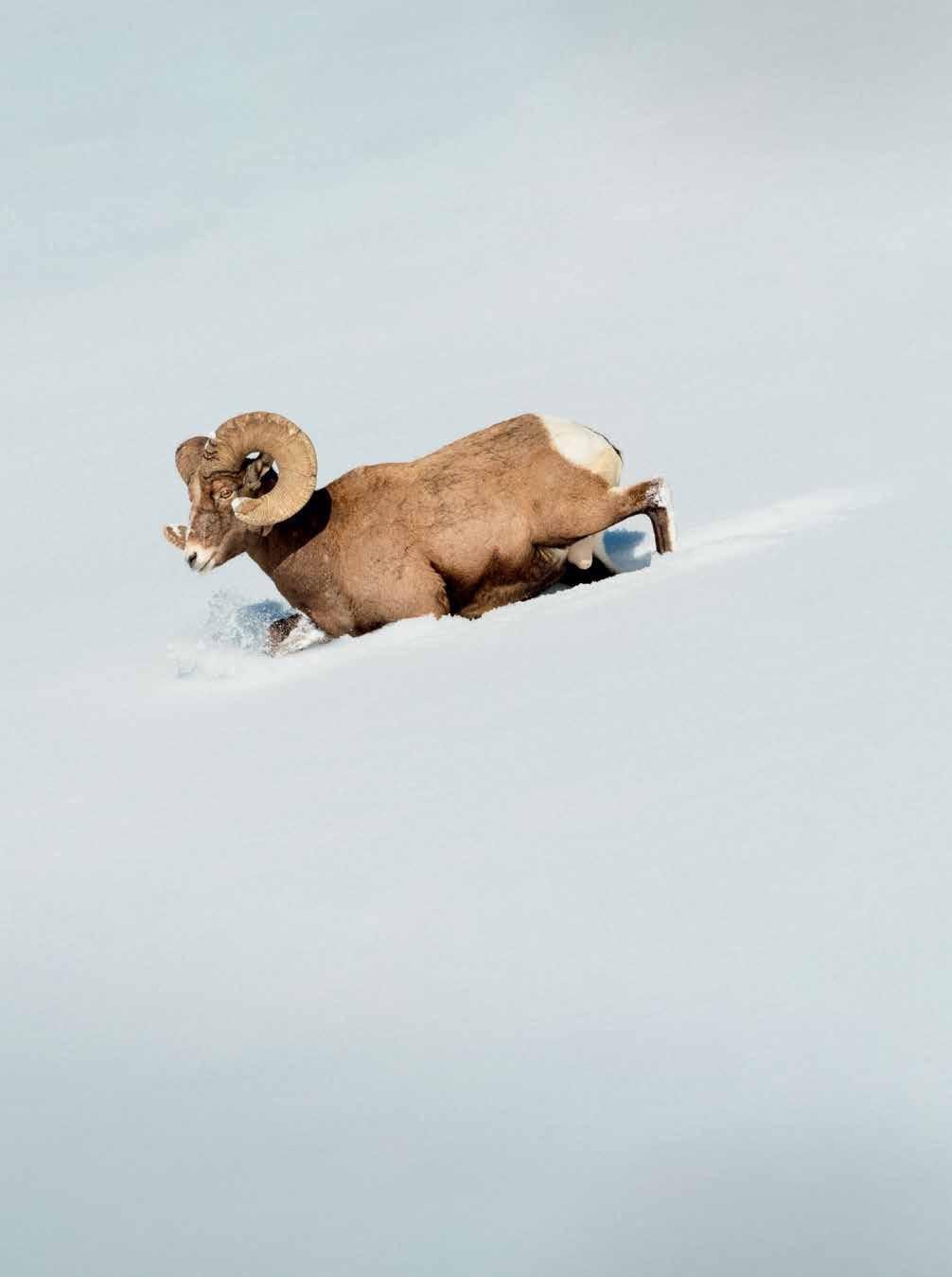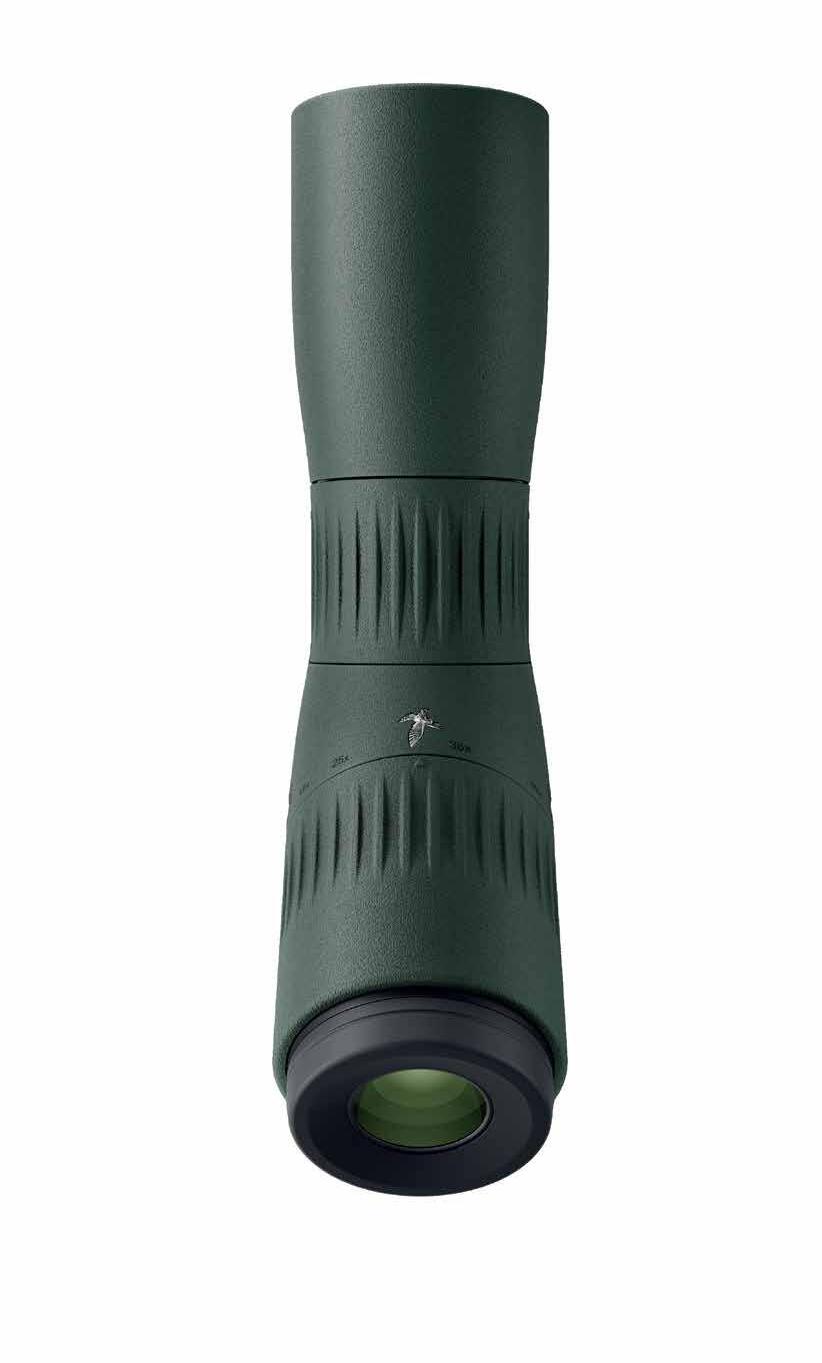






















Ice upon ice, night after night, until the landscape is bright and white with hoar frost. The cattle laying on the flat seem oblivious to the chill; they lay chewing their cud frozen condensation like a sparkling blanket across their backs.
Tendrils of steam rise from the cattle nostrils as they watch me curiously. I am worthy of their interest; my behaviour would pique anyone’s curiosity as I prepare to open the padlock on the chained gateway.
I know well in advance it will take more than a key to spring this latch. The padlock is frozen. Iced up both outside and in and the quickest, most e cient way to remedy this is to clasp it between warm bare palms and to hold on tight. This is going to hurt!
It does hurt. The frozen metal sears, burns like fire, but I hold on still. Only when the lock is warmed through do I release my grip and insert the key. It turns, and with a vigorous jolt I spring the lock and enter the frozen forest for a morning of piggin fun.
I’m not here to conquer the world. I don’t want to tussle with a mighty Boris, I
don’t want to remove farmland pests or to bring home the bacon. I’m just here to run my dogs. All four of them, at once, then go home, job done.
It is so bloody cold my hands clasp each other involuntarily, like a six and a nine, lovingly intertwined. I hunch into my oilskin vest, nose dripping, eyes watering. The dogs are happy though. They appreciate the Sunday fun run - the sni ng of urine of those who’ve passed before them, adding to the scent trails with urine of their own and a strategically place pooh or two.
Pigs will be where pigs will be, but sun is a number one, so I climb high in search of the days first rays. Up onto the ridge where the iced vegetation has begun to thaw and to drip. My two male dogs, father and son, quietly vanish into the Never Never. My two girls, greatgrandmother and wee pup, remain.
Far away I hear a distant squeal. The boys have found their quarry and I hope that Pearl, the old girl, will hear them too.
In an ideal world all four dogs would end up together and a pig would pay with its life. Goal accomplished. Run and done.
Kim Swan
Instead, Pearl encounters the hot scent of the distant squealer’s bed mate. Unfortunately, it has scarpered through the saddle ahead of me and it has a lengthy head start.
Unperturbed, Pearl puts nose to dirt, pedal to metal and smokes o with four wheels burning rubber. Little puppy is so impressed she follows suit.
“I’m with you Great Grand-Nan!”
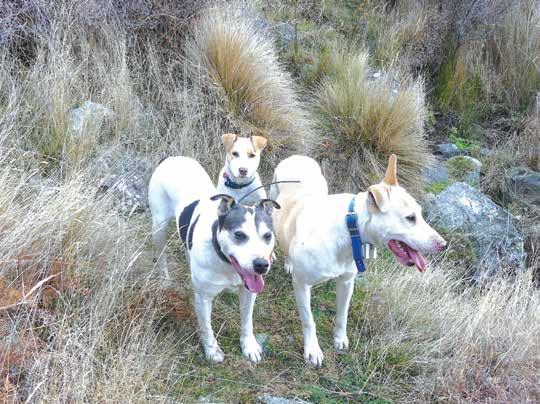
Okay, on one hand I have two dogs far distant to the west, in the other I have two dogs accruing metres at a furious pace to the south. Supposedly I’m managing this exercise programme, but I’m a part of neither team’s thought process.
The boys, they will be alright. The girls? That wee puppy is barely out of nappies, she’s literally a babe in the woods and she’s trying to stick hard on the heels of a Grand-Nan who will try, try and try. I opt to hike south in cold pursuit.
Later, as sweat melts away the chill, I
pause to consult my tracker. Both boys are question marks a kilometre to the west. Both girls are question marks more than a kilometre to the south. It’s fair to say the left hand doesn’t know what the right hand is doing.
I murmur to the gadget in my hand, “sheilas to the left of me, jokers to the right. Here I am stuck in the middle with you.”
The gadget does not respond. I press on.
Out here Pearl has looped back and forward, hard and fast, a figure eight on the ridge end and then another loop over the initial one. That pup, that wee baby girl, she is sticking like the
proverbial excrement to a woolly blanket. Fifty metres behind but never losing the scent trail of her mighty granddam. I am closing on them, just 300 metres for the intercept.
I’m not fantasising about heading o their quarry, about laying it low as it bolts past with tail and hackles high. Nope, it deserves its freedom. I just want my girls back, safe and sound.
Once I have them, footsore and bloodied, we veer west.
Westward question marks stutter into two tracks upon my cold trail. The boys are coming our way. Loyal and loving they run southward, following my prints in the frost.
Then I have them. Four dogs and I all regrouped. Their pads are worn and torn, their muscles tremble and they pause at every culvert head and weed-filled ditch to quench their raging thirsts. Together we limp slowly, heads down, but there is a quiet sense of unity between us, a bond that is not broken by momentary separation or small hardships.
The new kid on the block? The wee pup who shouldn’t be here but was just along for ‘the walk?’ She’s a keeper. A remarkable youngster who’ll inspire us all to greater things in future. Welcome to the team Coral.
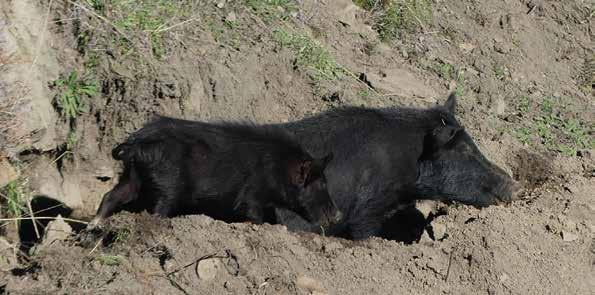
Yolande and I set out on our epic fishing adventure! We got to Cable Bay at an unprecedented 9am, a very late start for us girls. After a very quick set up we were on the water by 9:30.
I liked to play follow the leader with Yolande as I am the newbie, this trip out was only my second time catching any fish, with Yolande taking me under her wing the previous session and providing jigging lessons.
On our way out we had passed a couple of blokes making their way in, after a quick chat and good lucks, Yolande had given me the advice of a lifetime, she said “Tivie, one of the big mistakes that people make, is leaving too soon because the fish aren’t biting, and then wondering why they don’t catch any fish”.
In saying that, I got my first fish of the day nearly 10 minutes later, a 60cm snapper
was hooked on my line, man what a fight that fish gave me, many words were said before Snappy was landed…
After the quick and very talkative death of Mr. Snappy, we spotted a few boil-ups. A very eager Yolande zoomed past me, of course I made a swift paddle to the desired spot.
Many casts were made, emphasis on the many. Two kahawai were landed after a long and treacherous fight… by me.
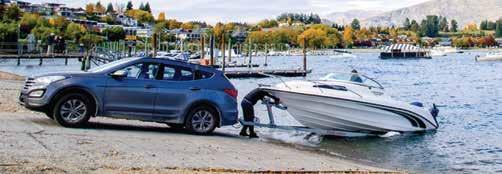
got your




Introductory offer Suppressor range 222 through to 30-06 41mm diameter 9”
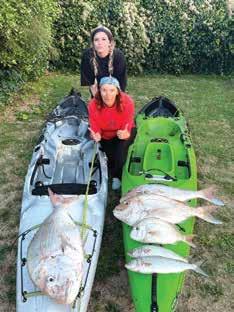
As much as I love to fish, I feel equally guilty when I am a fish hoarder. It turned out I needn’t have worried, Yolande was actually paying more attention to supporting me than she was to her own fishing and was thrilled to see her prodigy succeeding but I didn’t know that.
I made my way to an unlikely hookup spot in hopes of Yolande getting some action.
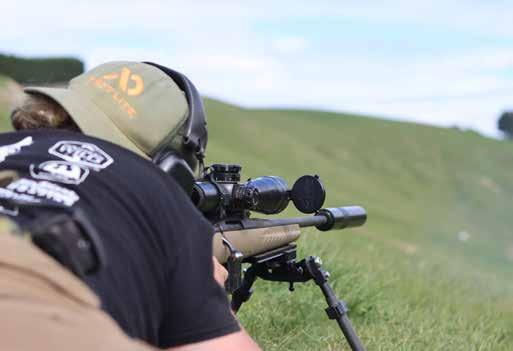
• The first is suitable for 22 Hornet through to 243 including, 222, 223, 22-250, 243.
• The second suppressor is suitable for 6.5 through to 30-06 including 6.5 prc, 270, 7mm-08, 284, 280, 308, 7.62 x 39 etc (not including 300 PRC or belted magnums).
• 9” in length (230mm), sits 4” forward & 5” back over the barrel (this is a “fixed” length and cannot be changed or added to)
• Weight 360 – 370grams (alu internal muzzlebrake 5-6,000 rnds)
• Colour - Black The 41mm 9” suppressor is most suited for those who like to clean their suppressor. We have two multi calibre suppressors available in the hybrid model and this is possible because the hybrid ba e system has tight tolerances allowing the small ranges of calibre. The hybrid ba e system also lowers the risk of stray bullets and bullet strike
I couldn’t not catch a fish for the life of me, and I had no choice but to bring home the bacon, scratch that, I mean fish. Yolande trotted around still seemingly optimistic despite many hours passing.
As I watched Yolande filled with guilt that she would leave with nothing, my rod nearly flew out the yak, “Great another fish for me.” Try as I may to reel as fast as possible in hopes Yolande wouldn’t see my luck, my kayak suddenly embarked on a lengthy sleigh ride, of course right in her line of sight… I landed my 65cm Snapper, put

him in the cooler and retired my rod… Yolande then turned her attention fully to her own fishing. In what seemed like no time at all, she flew past with the top of her rod tip near in the water, alternating between reeling like no man i’ve ever seen and line peeling out. There was a fair bit of splashing and attending to something. “OK” she calls “I’ve got a wee fish in the bag, I’m done but we can stay longer if you want to” and with some e ort, lifts her “tiny” fish (bottom left) to show me. As she calls it, “one and done!!
“We paddle to shore before we fall asleep on the water…stopping onshore for co ee and post-paddle analysis before loading up. I will never forget the wise words of Yolande as her day demonstrated to a tee.

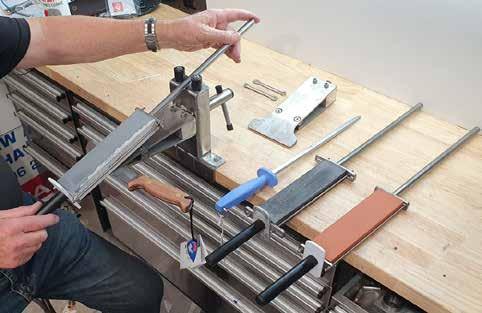

Join us at the Outdoor Expo in Christchurch, New Zealand, for an unparalleled adventure this spring! This September, get ready to shake o winter and step into a world brimming with the latest outdoor gear and technology. Whether you're looking to upgrade worn gear, repair cherished equipment, or discover innovative outdoor solutions, the Outdoor Expo is your one-stop destination. Featuring a diverse array of top outdoor brands,

we o er unbeatable deals to fuel your adventurous spirit. Immerse yourself in an exciting array of activities and attractions, tailored to delight every outdoor enthusiast.
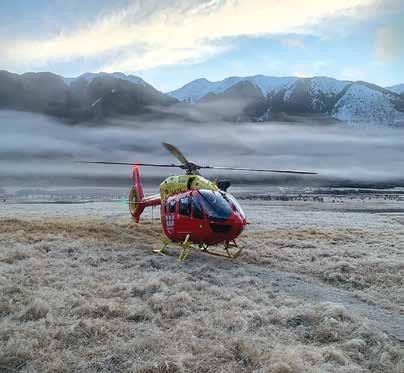


September 14th & 15th Christchurch Showgrounds

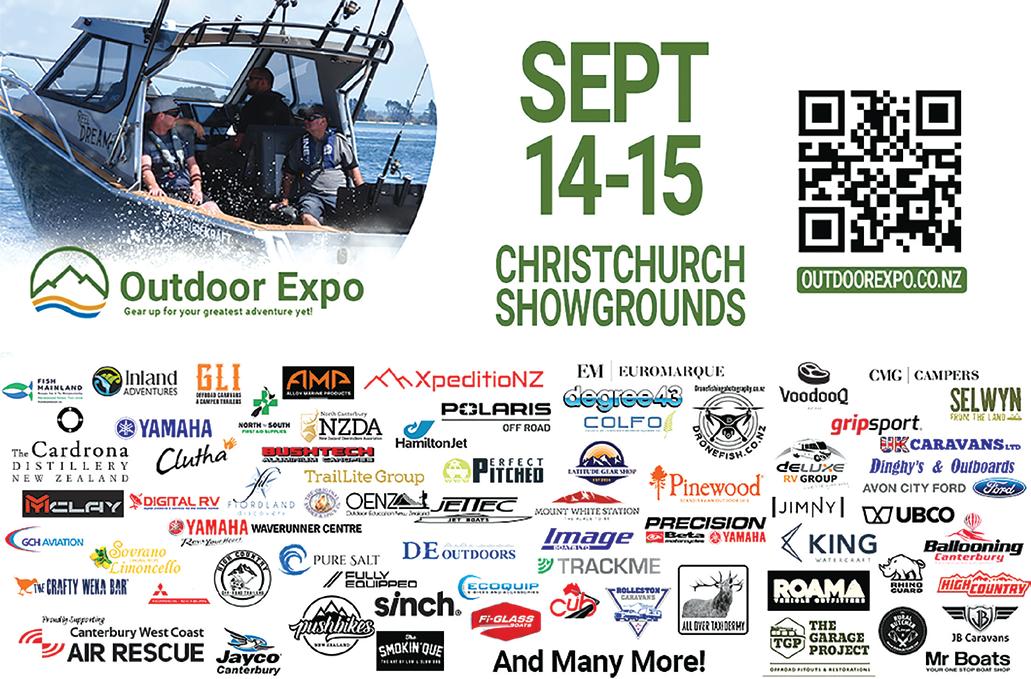

Matey’s question tinged my enthusiasm with some concern, because I certainly did – in a word 'we wuz skunked last time'. Oddly that day had been perfect, windless, glorious sunshine and the lake to ourselves. Ah, That’s livin’ alright (your earworm for the day, thank me later!) But skunked? How did these Americanisms infiltrate our language?
Thankfully we don’t have those creatures in New Zealand, but we have friends in Tennessee with an inquisitive dog that turned into a stinky dog after a skunk encounter. So we have these expressions, but I was sincerely hoping this time we wouldn’t meet even a metaphorical skunk, on a lake a bit south of Greymouth and somewhat north of Haast. Pardon the nonspecifics, but if I give it away our mates in Hokitika will be upset and yuh don’t wanna upset a good ole boy from downhome Hokitika. Enough already of those “isms”! I suppose we have to blame the mass media. We approached the lake with enthusiasm,
Ivan Wilson
Remember last time we were here?
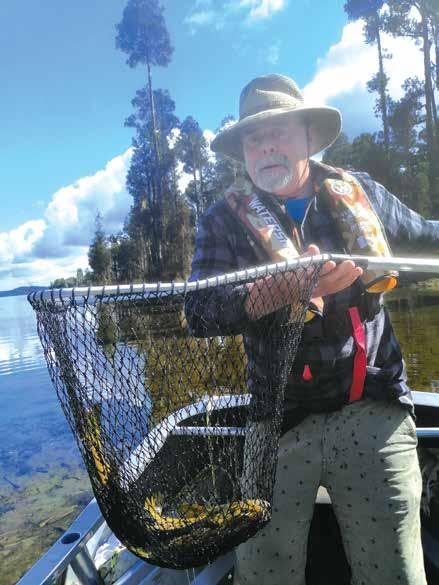
still underlayed by some misgivings in case Mr Skunk was still hanging about. Well founded fears they were, as even before we were in the boat, he contrived to give me a nasty squirt when I lost footing, slid down a muddy bank and ended up flat on my back. Matey didn’t see it happen or he would’ve hurt himself laughing, but thankfully he was away parking the truck. We always launch at a spot with a parking area and picnic tables, so there’re often tourists taking photos and ooing and ahing over the incredible scenery. This day a
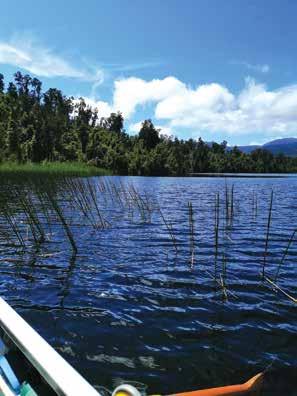
bunch of Japanese girls were there and caught my pratfall and of course they registered horror and amusement in equal portions. Hands over mouths and pointing, all in a polite way of course. They said "This
occidental acted like I’d done it purely for their amusement", then muddied but unbowed, I launched Silver Frog. Next I discovered my polaroids were not in the boat which gave me ‘roids of another sort, yes a pain in the - - - - - ! Enthusiasm overcame Health and Safety concerns about a fly in the eye or not cutting the glare, so we nosed o toward the first spot, where matey rose and quelled a thumper. Four and a half, perhaps five pounds of nicely conditioned fighting, fishy energy. We swapped places for my turn on the rod while he rowed, which is our regular pattern of doing things. He controlled the boat, keeping it at the right angle as I began to fish. Out amongst the mountains, conditions can change in a short time so when the lake surface was splattered with big droplets, out came the wet gear. Then it stopped as the sun came out. It became hot and o came the raincoats.
In a somewhat theatrical manner we became quick change artists from time to time during the day. However we’d stopped seeing fish, so the suggestion was made to fizz across to the other side where we’d done well in other times. A good call as after some concentrated casting I picked up a nice fish, then had the lack of skills to miss two
more. Didn’t see the takes, needed those polys, should’ve gone to Spec……. and other such excuses! Into a nice sheltered, sunny nook, where lunch was broken out and comments made about how privileged we are to live here and to enjoy lunch in such beautiful locations. We certainly don’t take our environment for granted (yuh listening extreme greens?) After lunch we continued drifting along the shoreline of flax, reeds, bulrushes and bush to the waterline, then got into several more nice ones. I had one that spat the dummy, matey picked up another good one, then I lost a nice fish – strategic mid lake release you might say. Time slipped by too quickly as it does, so back to the ramp we went, where various camper vans were pulling in for the night (hope they were self contained) On the run home, making a stop for a bit of fuel for the truck and ourselves, someone said “you two look like you’ve been having fun,”which summed up our day. We also beat Mr Skunk……sort of!


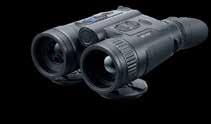
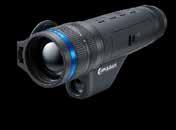


Three models available to suit various

Hand-held thermal imagers now allowed on DOC managed land.
The Department of Conservation has recently announced that hand-held thermal monoculars and binoculars are now allowed control and
The Pulsar Telos thermal monocular is the uncooled thermal to achieve <18mK
/ XQ30PRO
Pulsar Axion Compact Series thermal to last.

The sun was like a gentle kitten, quietly licking the back of my hand. It was mid morning in the Karoo and the temperature was still in the pleasant range. An ancient dried up inland sea, the Greater Karoo is a vast savanna landscape sculpted by millennia to resemble nothing else on earth: undulating terrain, huge plateaus, monument-like outcrops that plead for room with the sky, and wild animals that cluster like fleas on the hide of the world.
I was crouched behind my PH and good friend Pete Wenham and he was excited. We were stalking a herd of mountain reedbuck and the chess game was not playing out in our favour; open
country, little natural cover and a gypsy wind was giving the advantage to the animals. However, Pete’s ever roving eyes had picked a ram where he ought not have been.
“He’s got to be a taker! Pete whispered as he fixed it through his binos. My Swarovski 10x42s pulled it into focus and I realised it was not alone; a small harem of ewes fed around it. “The fact that he’s miles from the main herd and holding a couple of girls suggest he’s an old campaigner.”
Perfect. As a trophy hunter, I’m not motivated by the tape measure—I love the pursuit of old animals, past their prime, that have served the gene pool well and outwitted countless
other hunters in doing so. If I can take one at the end of its life, I’m satisfied; especially if I have had to work for it. And you have to work for your animals in the Karoo.
The stalk was tortuous: winding through dry dongas or creek beds, crawling on hands and knees through savanna grass and sidling Indian file around the mountain face to close the gap to a comfortable shooting distance.
I’m an old fashioned
Daryl Crimp
hunter—a stalker— not a long range shooter, so the thrill for me is getting close, undetected. I like to see the eyelashes of my quarry before I pull the trigger.
This old ram was in a somnolent state, induced no doubt by the warmth of the direct sun and the contentment of a full belly. His horns were thick at the base and broomed; We’d closed the distance to 120m so I could now see this with the naked eye. It
had taken us over an hour to close the 400m from where we first spotted him and he was still none the wiser we were there.
The shot was on— he was broadside and in plain sight, but time was on his side—as Mick Jagger so beautifully put it! I savoured the moment awhile longer and pinched myself; I was hunting Africa—a dream so many have, but neglect to realise.
The shot ended my
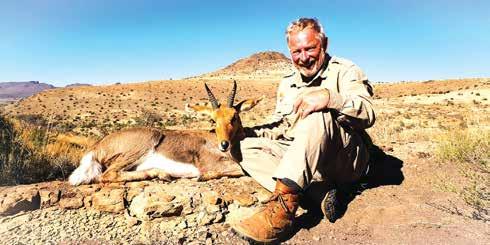



reverie but not the memory.
However, I had one last act to administer.
Walking up to the old campaigner, I bent and plucked some hair from its flank. Standing, I solemnly cast the bristles to the wind. It’s an ancient custom of the African Bushmen, said to show respect to the animal and help it on its journey to the next realm. You do that in Africa
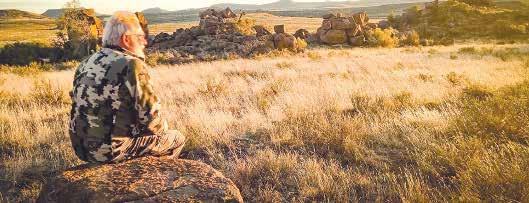



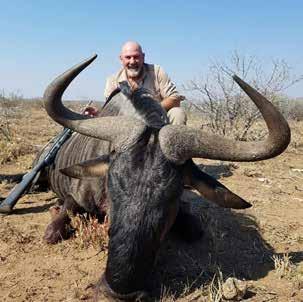

down?) This also gave the gangs a holiday from the careful watch of police and their membership subsequently increased.
The licenced shooters in this country have been getting a hard time the last few years, and in most cases its unfounded and over the top, and we should be asking ourselves why is that?
We have seen the figures and statistics; violent crime has gone up, the ban and so called buy back, netted stu all, but cost us over $200,000 in tax dollars. Which, no surprise, only resulted in honest people participating. Hell the gangs had been on TV saying they wouldn’t hand theirs in, (how come they have any and the police aren’t kicking their doors
Now we have The Firearms Safety Authority, which has been set up and run under the police. While the Minister of Justice has taken a change at the top, nothing has changed in the way they deal and treat the licence holders.
After the massacre in Christchurch, Police were silent about what vetting and checks properly were done but nothing was done when discrepancies were identified.
The paperwork to apply for a licence is an obscene joke. It's about making those that want to follow the laws and have a licence think twice and in a lot of cases, just plain give up.
We know that the desire from a lot of people is to disarm the public, even when they say otherwise, because actions show this. If you don’t believe me, go and download the application form for a firearms licence and note they are the same whether it’s for a new application or renewal, then look at a driver’s licence or Passport application where a renewal is relatively simple.
The over-the-top watch on pistol clubs and ranges has put so much extra pressure on the volunteers who are just trying to keep their clubs going and to give people a safe place to learn the right way to handle a firearm
They try and claim it is about safety, but is it really? Accidents have always been rare and normally
self-inflicted. Accidents will happen but do the math, every Pistol endorsed holder has to shoot a minimum of 12 times per year and I would estimate they shoot about 150 rounds per visit, some do less, but others more. This means 4600 members x 12 shoots x 150 rounds = 8,280,000 pistol rounds on the minimum, and believe me, we do a lot more than that.
If you are wanting good, knowledgeable advice and experience to back it, talk to Pistol NZ, NZ Deer Stalkers or COLFO. They talk and live it, firearms and their use, damn near every day and have done so for
years. Not the police who shoot two times a year and mostly on other people’s ranges. It’s time that smart people who know the subjects are at the front of the room, and those that have gained their expertise from Facebook and just run on feelings get limited time to speak as there is little benefit, in my opinion, to what they have to say.






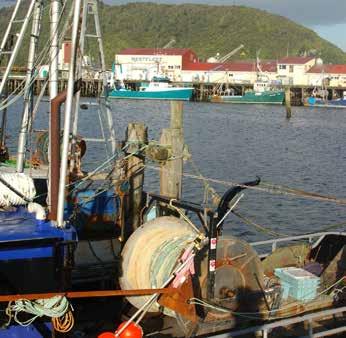


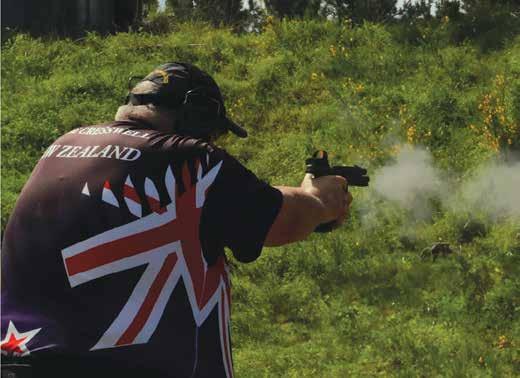
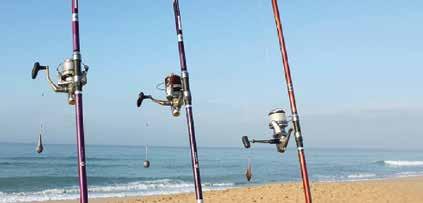
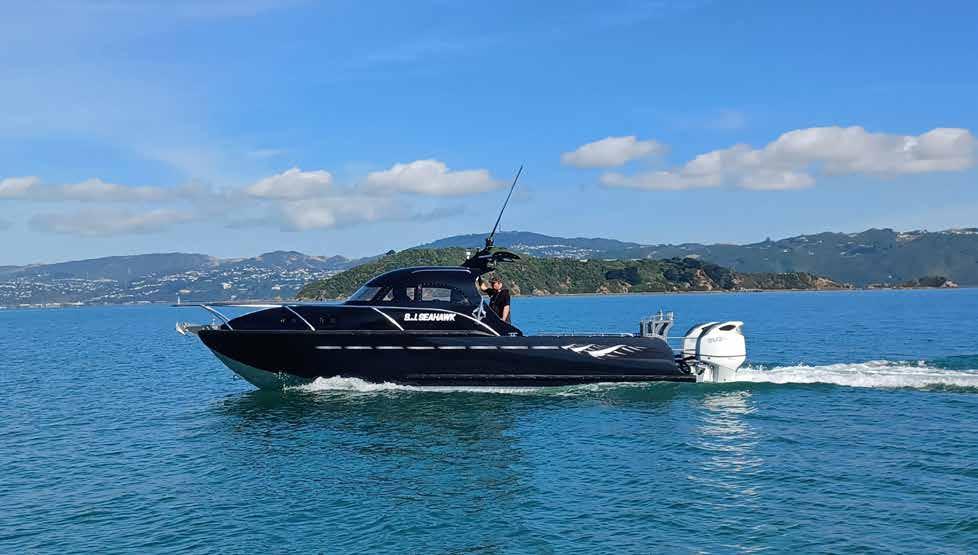

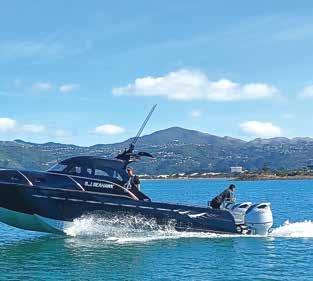
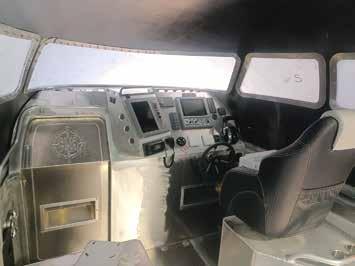
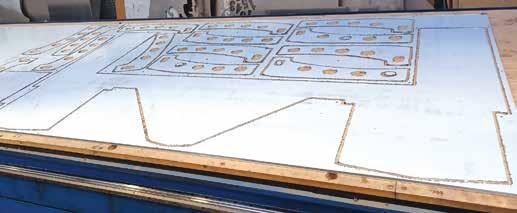


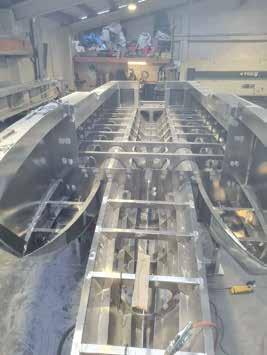
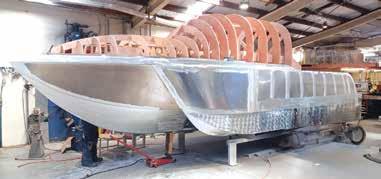
There was a mark on the side of the hull where Phil wanted the boat to float – and it did.
Towing the boat to the marina, the economy light on the RAM went on – indicating that the aerodynamics were pretty good.
Suzuki had supplied propellers based on their speed estimates for the boat - the 19.5” were a tad small with the boat redlining very quickly.
Graham from Suzuki
NZ came down and the 25” propellers were fitted, two runs later 52 knots and then 54, so 101 km per hour through a 25 knot southerly.
Whilst the propeller could go bigger the decision was made to stick here – the boat will normally be fully loaded and it’s about comfort and soft ride.
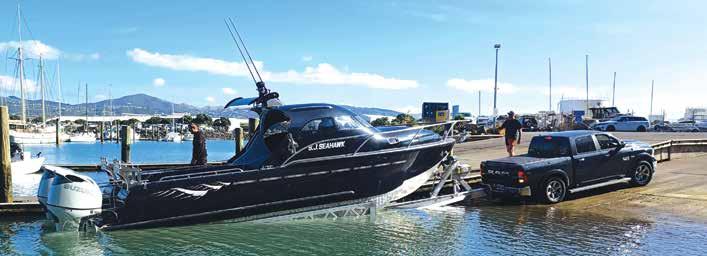
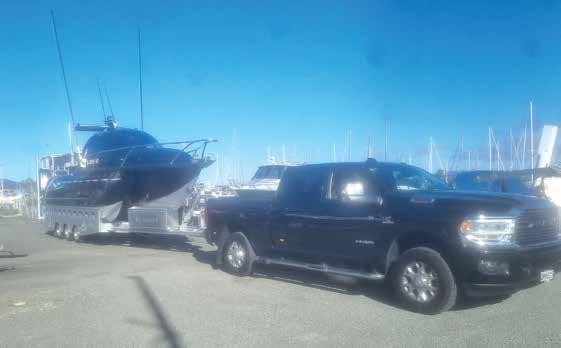
The boat has had strong interest from a number of marine businesses who are looking at replacement or additional vessels – it is well suited to serious fishermen, game fishing and could
be modified for cray as well.
There could also be a role within marine rescue , for coastguard, police or airports with tailored design on the base boat available.



The learnings from this first build will allow a faster more e cient build process and Phil is sure that the first order will not be far away.
Initially a Ram Laramie was purchased through Brent Boddy Prestige - with the boat and trailer weighing in at 4570 kg there was a need for a sound towing solution , whilst also a comfortable ride for those long distance road trips.
Not long before
Seahawk was launched a new Ram came on the market and with a far superior towing capacity, the Laramie was traded in.
The new 2500 Dodge Ram rated at 6.9T towing capacity with torque generated by a Cummins diesel had enough
power to make Phil have to check in the mirror that there was a boat on board.
The increased towing capacity made the model swap a no brainer providing far better on road stability , added comfort and increased safety.
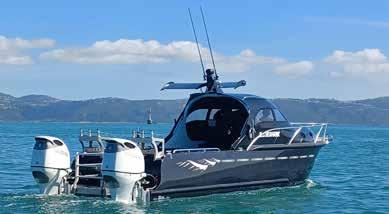


Phil Morris built the Eliminator boat 26 years ago and the boat was seen widely throughout the North Island and top of the South.
His many hours spent refining and enjoying the Eliminator and his 40+ years of experience working on a wide range of marine craft led Phil to believe that boat design could be done di erent –and better.
The Eliminator was a tri-hull wave piercer coming in at 7.6 m – handled well into a head sea and was stable at rest.
The traditional monohull design has been recreated
in every shape and form and whilst the materials used to build the monohull have moved with time there have been no real improvements on the hull design. The US navy were using advanced multi hull designs – was this the way to go?
What were the design elements that were important?
• Fast
• E cient
• A working recreational fishing boat not a cruiser
• Ability to handle the rough
• Both the design and the visual perspectives were important
Using SolidWorks and the CNC router the basic hull was cut out – interestingly the basic design for the hull did not change from those original sketches. The team pressed the main tunnel sections –with extreme accuracy required for the multiple folds. Then the ribs and the bulkhead
were formed up – using a jig on the workshop floor with aluminium strops holding it all together. As the basic form took shape the hundreds of individual pieces needed to be aligned until three months later the basic hull was finished.

• Form and function needed to be aligned.
• Ride softly.
• Maintain high average speeds.
• Be very stable at rest.
The basic design was sketched on large pieces of paper on
The cabin design initially sketched out just didn’t work – it needed to be highly functional and visually appealing with key elements being aerodynamic function minimising wind drag and maximising cabin space.
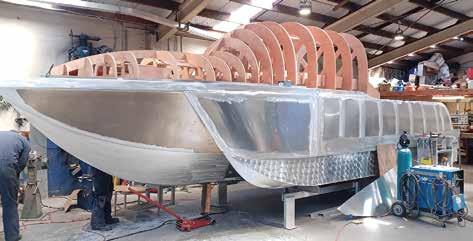

the kitchen table over the course of a year in Phil’s spare time – Phil could 'see' the boat in his head and used the sketching to recreate and refine this vision into design plans. The original sketches are discarded in the corner of the o ce.
These sketches were then handed to SolidWorks guru 'Sam' who transcribed all the sketches into the SolidWorks design program. There were a dozen or more iterations of the original design – refining and fine
tuning to ensure that technically the boat was looking ok. From the sketches first appearing on SolidWorks through to the design being ready for construction took approximately six months.

A local craftsman who could build the cabin in carbon fibre solved many of the design challenges for Seahawk being that the cabin would be strong, lightweight and holding its complex unique shape. The cabin top was sketched out for Sam, to then draft into SolidWorkswith Sam's skills , less than three hours later the first design was generated and then following revisions it
was cut out in ply using the CNC router. The ply profiles made the rib structure for the cabin top. SolidWorks allowed a 'stickman' to simulate walking around the cabin top design so that those taller members of the crew weren’t going to bash their heads. The ply ribs were then connected and lifted o in one piece - the composite craftsman then clad the frame with 40mm wide pieces of timber
and then the carbon frame was layered over that, smoothed and then vacuum packed and infused. Once the top was back it was dry fitted allowing all of the internal design, dash and instrument panels to be scribed into place. Then it was o to the painters. After the cabin top and hull were painted , they were fitted permanently together. The final cabin weighs in at an astonishing 63 kg.
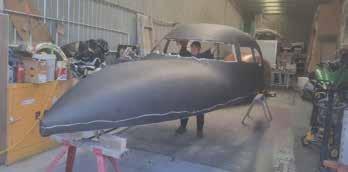
Something that makes the Seahawk stand out are the unique wings that appear on top of the cabin – they really do make the boat fly with the design con-
cept being to make use of the wind coming over the top of the cabin to generate lift. There will be some drivers in Wellington who watched in
amazement as the Morris Metal trucks drove up and down the motorway with the wings attached to the truck deck modelling the lift generated by


One learning from when the Eliminator was built - Build the trailer first so that you can move the boat framework around. Sketched initially on paper and then transferred to
DesignWorks by Sam.
The trailer is 11.7m long. The side pieces are cut from 10mm plate and act as the main trailer chassis as well as the wheel arch structure. The trailer weighs in at 1400 kg.
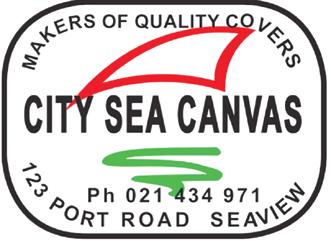
For all your canvas and upholstery work, from squabs to heavy industrial canvas work, John has the knowledge and experience to deliver an exceptional product at a reasonable price. He's a trade certified canvas worker with experience in: the marine industry , recreational vehicles and general canvas goods.
the wings. Boeing airplane modelling indicated lift of 490 kg at 100km per hour. This unique design lightens and stabilises the boat with the lift being on top of the cabin.
The actuator can be manually altered using a push button to change attitude of the wing – and it looks great.
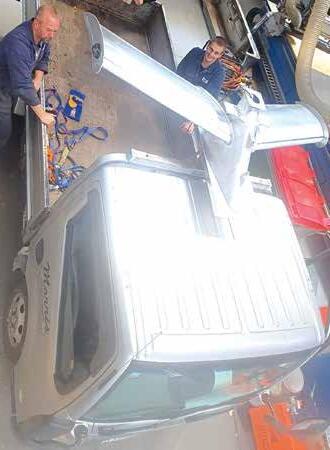

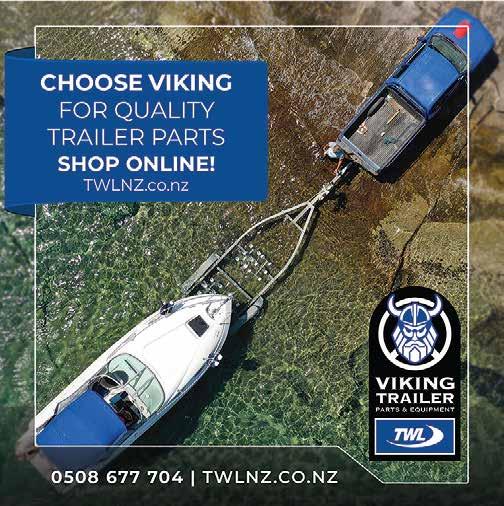
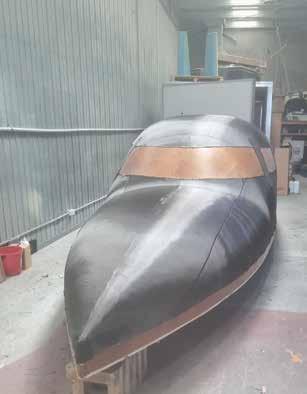
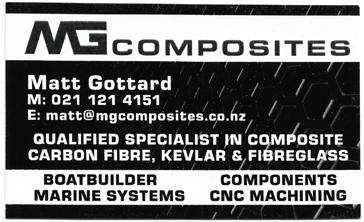
Matt's services include composite component manufacture, CNC router cutting, and SeaDek marine flooring installation.
MG Composites can even manufacture custom CNC cut moulds and patterns in-house to help reduce lead times and improve accuracy for our customers. At the moment Matt is working on a row-boat - to cross the Atlantic!
Twin DF 350 Suzuki’s were chosen after an exhaustive search based on the new dura prop system and on fuel economy. They took several months to arrive in the country and the boat was nearly ready for them when they arrived preChristmas.
Once the motors were chosen, the hull was designed around them – wooden cutouts were made early in the build process so that the motors could be positioned in the correct place – their very narrow power heads could draught in behind the sponsons.
KP Marine were responsible for sourcing and then fitting the motors.
• A fusion signature series sound system was fitted to lull the fish into submission
• Koden was

used to supply and install the commercial fish finding equipment – simple to use and graphics were easy to decipher for fisherman .
• All the standard communication devices have been fitted with USB ports scattered through the boat as well.
• LED lights have been fitted under the gunnel and soften at night so as not to be too harsh.
• A 6000 lumen
360-degree spotlight on the roof works o a handheld remote.
The Cabin: it’s a fishing boat not a luxury launch but there has been a lot of thought go into the design.
• Room for five people
• 115 L chilly bins which clip into place and double as seating and storage.
• Generous berth down below for a snooze with porthole windows for fresh air, carpet,

3 Plimmerton Drive, Plimmerton, Porirua 5026
https://www.kpmarine. co.nz/ boats@kpmarine.co.nz 04 233 6164
KP Marine has been in the marine industry since 1969, focusing on helpful and professional service for all things boating, fishing, diving, engines, clothing and more.
KP Marine supplied and fitted twin DF350 engines to SJ Seahawk and worked with the Morris Metals team and Suzuki Marine during the commissioning phase.
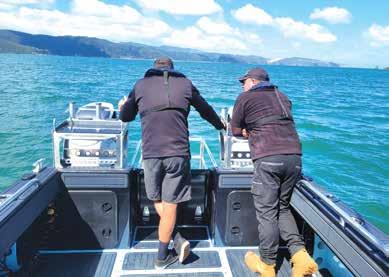
led lighting and storage nooks.
• The forward bulkhead contains all the anchor warp and chain capstan mounted inside to not disrupt airflow – there should be no need to go forward into this area.
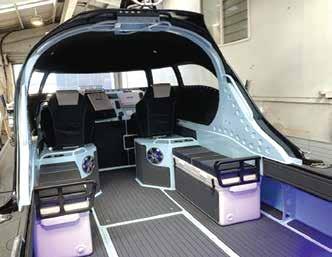
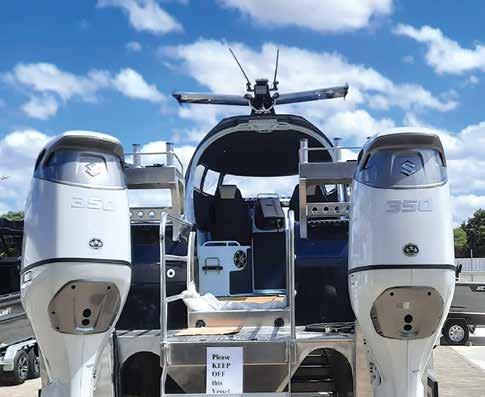

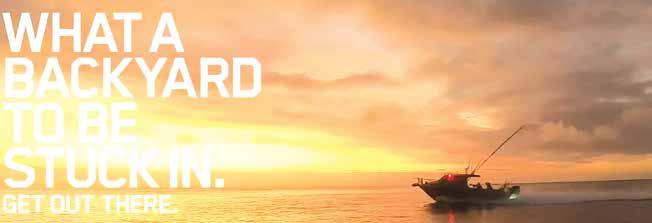
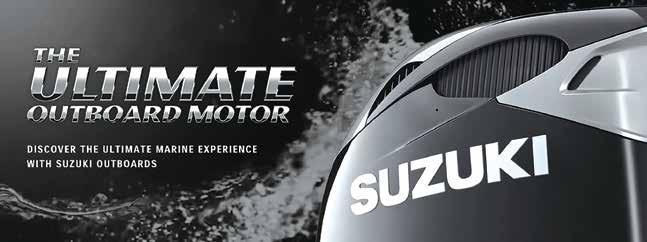
This build was a team e ort - the Morris Metal Team of Phil, Mark, John, Sam, Aaron and Alex were all involved in the build process.. The build was supported by an amazing group of suppliers who went above and beyond to help build the SJ Seahawk.

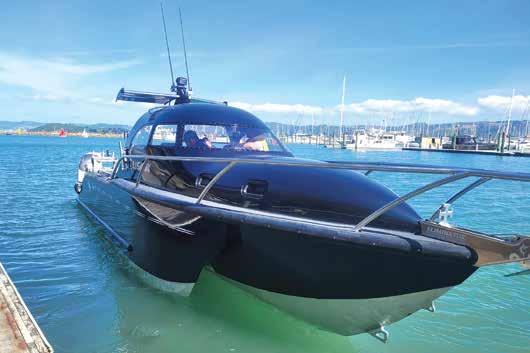
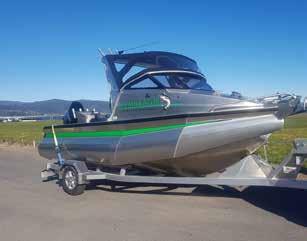



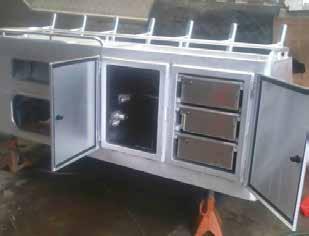



Pāua is one of New Zealand’s most iconic seafood species. It is popular with recreational divers, an important customary species and supports a valuable commercial industry.
Pāua are a member of the wider abalone family, of which there are over 50 other species around the world. Abalone are large marine gastropod molluscs, in other words, big sea snails. They are generally characterised by the flat spiral shaped shells with a string of respiratory pores along the edge. It is the ‘ear-shaped’ shell which give abalone its family name Haliotis, from the Greek halios (marine) and ōtos (ear) or ‘sea-ear’. The inside of abalone shells is composed of iridescent nacre giving it a striking appearance making it popular for jewellery and decoration. Abalone are prized for their tasty meat which is widely considered to be a delicacy. They typically inhabit rocky reef habitats throughout the temperate regions with some species distributed through the tropics. They live at di erent depths depending on the species.
Abalone have historically been an important food source for indigenous cultures, with first reference made to them by Aristotle 2,500 years ago. These days they remain an important food source for coastal communities worldwide and in some places are part of commercial fisheries. Here we
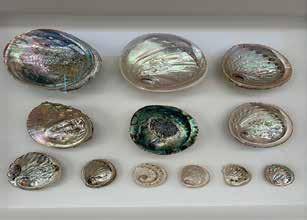
look at some of the other well-known abalone species around the world and compare them to what we have here at home.
Starting across the ditch, Australia has 18 reported species of abalone with three that are commonly harvested. The greenlip abalone (Haliotis laevigata) is found in the southern waters of Victoria and to Western Australia (including the northern edge of Tasmania) it is characterised by its bright green perimeter of the foot muscle. They grow up to 23 cm in length and are found in depths up to 30m. Blacklip abalone (Haliotis rubra) have a similar distribution and habitat to greenlip and grow up to 20 cm, but they are distributed further south around the extent of Tasmania. As the name suggests they have a black lip to the foot. There are well established commercial fisheries for blacklip and greenlip abalone around the southern states of Australia
with most catch from South Australia and Tasmania. The management of these fisheries is quite sophisticated, especially with regard to the minimum size limits that are implemented in recognition of the biological variation in populations in di erent regions. For example, there are five di erent size limits for black lip abalone around Tasmania.
Another popular Australian species is Roe’s abalone (Haliotis roei), which is found in shallower waters and has a maximum size of 120 mm. Roes abalone is a popular recreational fishery, particularly in western Australia where it is managed very strictly with fishing only able to occur on four Saturdays of the year in suburban areas.
In South Africa the most common abalone species is known as perlemoen (Haliotis midae) which is distributed around the southerneastern aspects of

Dr Tom McCowan
South Africa. They are found in depths up to 10m and grow up to 25 cm. They have a brown outer foot and characteristic thin and deep corrugations on the outer shell. The perlemoen has been subject to extreme poaching for decades for its sale on the black market which has caused serious decline in this fishery leading to its endangered status. Most perlemoen industry is managed through aquaculture which also supports reseeding e orts in some areas to enhance and restore natural populations.
There are seven species of abalone found on the Pacific coast of North American (from Alaska to Baja California). The most well-known species on this extensive coastline is the red abalone (Haliotis rufescens). The red abalone is the largest abalone growing up to 30 cm shell length and they can live at depths up to 40 m. This species has experienced serious decline over the past few decades as a results of disease as well as intensive fishing at unsustainable levels. This has seen the closure of the commercial fishery and a very heavily regulated recreational fishery which operates under a ‘tag’ system where exact numbers of abalone taken by divers can be accounted for, but has also been closed since 2018.
Other species in North America are also in decline as a result of disease, habitat degradation, warming waters and fishing at

Japanese ‘ama’ (from: https://www.japantimes.co.jp/ news/2015/03/17/national/traditional-ama-diving-at-riskas-numbers-plunge/)
unsustainable levels.
For example it is estimated that the pink abalone (Haliotis corrugata) is now at 1% of its biomass compared to the mid 1900s. Restoration programs are in place for several of these species which are now considered endangered.
In Japan, abalone are called awabi with the most common species being Haliotis discus. Abalone diving is engrained in Japanese culture with harvesting traditionally being undertaken by “ama” (female divers).
production is almost exclusively through aquaculture of Haliotis discus hannai and Haliotis diversicolour. These are smaller abalone species that are favoured by China’s domestic market. Abalone production through aquaculture in China is more than 200,000 tons which accounts for more than 85% of global production. This is enabled by expansive sea ranching and aquaculture facilities that cover miles of the coast line.
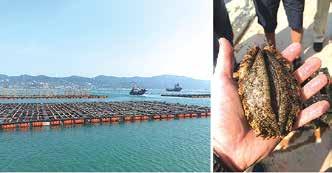
Small scale wild harvest fisheries still exist in Japan where ama dive for awabi to service local markets, however the fishery is strongly supported by large scale stock enhancement through reseeding.
China is the largest market for abalone worldwide due to its massive population and the popularity of abalone in China. In China, abalone
Now back to Aotearoa – we have three species of abalone known locally as pāua.The two lesser known are the virgin pāua and queen/ yellow foot pāua (Haliotis virginea and australis respectively). Virgin pāua are the least common, they grow to only 80 mm and are found right up in the shallows in boulder habitats. CONT on bottom of page 16

“It’s incredible the change in technology just in the last twelve months,” says SnapCore CEO Chris Rodley in reference to the capabilities of cameras for vessels. Not only can they provide better protection for the privacy of crew members, he says, but they can also identify bycatch, bird presence or even decipher between a net being on the boat or in the water.
The latest AI camera unit to be launched by the Nelson-based company has capacity to store enough data for an entire fishing season and gives capability for real-time analysis of what’s in view anywhere in the world thanks to solar powered GPS and satellite communication systems.
This system, which is not much bigger than a pack of butter, results in the ability for active monitoring without the need for an observer on board. Its capabilities include species di erentiation to the point it can identify a bluefin tuna from yellowfin, and facial blurring at the time of data capture so a crew member’s identity is protected even before footage is saved to the hard drive
Yellow foot pāua have a bright yellow foot and resemble a smaller version of their Australian cousin, the blacklip abalone. They can grow up to 110 mm and are reasonably common through most of NZ, inhabiting the top of rocks and crevices.While they are quite tasty, they are not a commonly targeted fisheries species.
or transmitted.
The new system, called Snap AI, not only protects privacy and reduces storage and review costs, says Rodley, but also gives scope for the industry to achieve greater value for products.
“Consumer trust – trying to bring an incontestable record of the products caught – is significant but there are moments in the lifecycle of the product that are really interesting, that demonstrate quality, and di erentiates us from other markets around the world,” he says. “I think telling that story is key and using this technology to do that is powerful while protecting the identity of those on board.”
SnapCore’s AI camera technology is already being used widely on fishing vessels in the USA.
“One of the benefits of the new system is it can be programmed to identify ‘moments of interest’ which for some markets in the USA – as far as the regulator is concerned – involves identifying bycatch species,” says Rodley. “To have a human on board makes compliance costs high, but using our technology means they’ve seen heavy reductions in some markets".
“Instead, AI identifies any moments bycatch is landed and then a reviewer on land can be notified to watch just that portion of the footage. We also have the facility to allow for weighing and measuring those fish automatically.”
In some cases on trawlers, around 80% less footage has to be reviewed, he says.
“What we talk about is making the video reviewers superhuman,” says Rodley. “The goal is for surveillance and monitoring to be as seamless and coste ective as possible and provide the best data to the regulator while protecting the privacy of the crew members.”
It’s hard to believe SnapCore started out as two brothers – Chris and Andrew – working from a garage. Having recently moved to new premises near Nelson Airport, the organisation has invested in, and made in-house, machinery to manufacture the hardware on-site. Since its inception in 2007 the firm has now grown into five business units coming under the umbrella of SnapCore, with Teem Fish monitoring
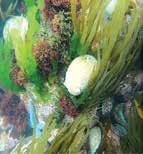
The abalone we are all most familiar with is the blackfoot pāua (Haliotis iris). Common around the
responsible for vessel camera technology.
“From day one our desire has been improving transparency and reducing compliance cost,” says Rodley. “Now our cameras are really robust and capable of going 2000 metres under water. We’ve designed it, we manufacture it here in this factory – it couldn’t be more ‘made in New Zealand!’”
He notes that although a human reviewer on a boat takes an hour to watch one hour of footage, portions could be sped

up with a traditional electronic monitoring programme. “If you add AI with an audit process though you can even more significantly reduce the time it takes to review just by focussing on those key moments.”
Another advantage to the firm’s AI breakthrough is that the technology requires no additional training for each application. “In the past it was very challenging to build a global model so each single vessel’s technology would require individual training,” says Rodley.
The firm now has cameras on vessels in Canada, Australia, and Pacific and Indian oceans, as well as the USA, with a contract for the latest AI-enabled version already in place with New Zealand firm MacLab. “In the future, the obvious next step for this technology is to assist in the creation of an automatic logbook submission, which gives further reduction in e ort by the crew.”
If Rodley and his team have their way this won’t be far o , he says.
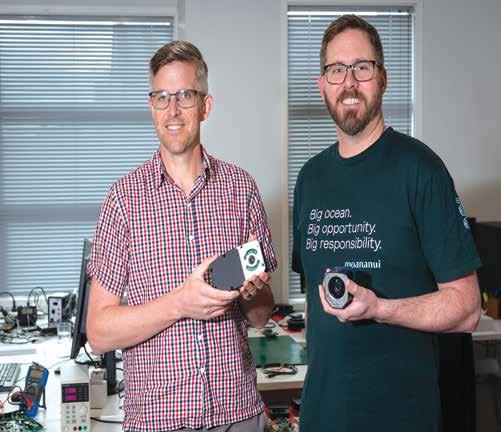
extent of NZ’s rocky coastline living in depths up to 15m and growing to 200 mm. The blackfoot pāua is characterised most obviously by its brilliant iridescent blue/green/ purple inner shell. It is this colour which gives it its latin name ‘iris’ from the Greek ‘rainbow’. Blackfoot pāua also obviously has a very unique and characteristic all black foot.
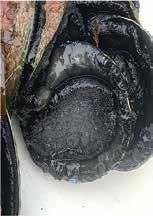
The pāua fishery in NZ is one of the last remaining wild caught commercial abalone fisheries in the world. Abalone fisheries around the world have a poor track record of decline and collapse so it is vital that we continue to carefully manage this fishery as we are; primarily through the implementation of industry based management
tools. The fishery is also of high importance to Iwi and recreational divers. With increasing participation in recreational dive fisheries it is critical that we carefully monitor and manage catch across all sectors to ensure ongoing sustainability of this fishery for everyone
Last month, I outlined the advantages of using a hand-held thermal monocular on DOC managed land. Just to recap, they are:
• Safer target identification
• Carcass and wounded animal recovery
• Pre hunt reconnaissance
• Spotting and stalking
This month I would like to discuss the new Pulsar Axion XQ30
Pro thermal monocular that is manufactured in Pulsar’s new factory in Latvia.
This thermal is the lowest priced in Pulsar’s range and ideally suited for bush stalking and general hunting. The New Zealand Police recently evaluated the Axion XQ30 Pro and purchased 16 units, which is testament to its performance and Pulsar’s reputation amongst professional users.
Pulsar Axion evolution
The original Pulsar Axion XM30 was launched in 2019, becoming an immediate success with hunters due to its ultra-compact size and entry-level cost. All XM Axions were fitted with a Lynred 320x240 12µm sensor, while the new Axion XQ30 Pro is fitted with a Lynred 384x288 17µm <25mK sensor. This is a significant performance upgrade, providing better image quality and deeper foliage, rain and mist penetration.
Ant Corke
Other hardware features include a Mg-alloy housing that is robust, fully waterproof with excellent internal heat dissipation, precision ground 30mm f1.2 Germanium lens, AMOLED 640x480 display and a lens cap that magnetically attaches to the hand strap to keep it out of the way while in use. Its operational functions are now the same as all other Pulsar thermals, such as video recording and streaming, updatable firmware, multiple colour palettes to name a few.
The device is powered by an APS3 battery, which is easily removed by pressing a button on the front of the unit. Run time for a battery is over 6 hours in winter, though extra batteries are modestly priced, last many recharging cycles and will keep you hunting for longer.
The Axion is very light and compact, while the ergonomics are very good with easy-to-use control buttons, precise objective and ocular lens focussing, and a comfortable handstrap. Its small size is easily slipped into a pocket and its build quality is typical Pulsar, solid and very refined. What it is good for
The Axion XQ30 Pro has a 2x magnification and a field-of-view suitable for use in bush, forestry and farmland. It is very handy when walking long distances without taking up much space.
The image quality is the best that I’ve

yet seen in an Axion, very similar to its higher cost stablemate the Axion 2 XQ35 which uses the same sensor. I spotted cattle at +1Km, rats at +100m and possums at +200m, though to be fair, it was a little misty at the time. At these distances, the respective animals were small ‘blobs’, but identification was made by the way each animal moved. I was impressed because the performance exceeded my expectations, having used the previous Axion XM30 models many times.
Observing my son walking in native bush at around 60m, I could clearly see him as an upright walking critter, despite him being invisible to my naked eye. There is no way that I could have mistaken him for a deer. The Axion’s new Lynred sensor certainly gets my thumbs-up for foliage penetration. What it is not good for Distance performance is limited, so if you need to spot and identify
animals at greater distance, there are better options in the Pulsar line. Long distance performance requires larger optics and/or a bigger sensor. Safety is foremost and it’s the hunter who pulls the trigger, not the optic. Bide your time, get closer and identify your target beyond doubt.
The Axion’s lack of a laser rangefinder is not such a problem in daylight when an optical laser rangefinder can be used. On private land at night, the Axion’s interactive stadiametric rangefinder is su cient
for shooting deer with a flat shooting rifle at closer distance; simply preset the range and approach until the animal fits the stadia marks. If a laser rangefinder is an important consideration, the Pulsar Axion 2 LRF XQ35 or Telos LRF XQ35 are better alternatives.
My conclusion I’m lucky in that I have access to a wide range of Pulsar thermals, ranging in price from the Axion up to the ‘high-end’ Merger LRF XL50. I like them all in
their own unique way, but if I’m out walking around my own property, long distance performance is less important than foliage and inclement weather performance. My paddock is around 375m long and the rest of the property is a mix of plantation forest, native bush and tracks, perfect territory for the Axion XQ30 Pro.
At $2599, the Axion XQ30 Pro is excellent value-for-money, very well built and like its predecessors, will provide many years of reliable service.

As a nation, New Zealand has an enviable record of invention and innovation. There are many examples of the outputs of the number 8 wire approach to both industry and commerce – some quite spectacular, for example the Hamilton jet or the Gallagher electric fence. Innovation and entrepreneurial endeavour have been strong in the rock lobster industry for as long as it has existed. A study of the history books will confirm there was a domestic market for rock lobsters as far back as 1772 when the explorer Furneaux completed a transaction with Cape Palliser Maori, when he bought ‘a great quantity of crayfish’ with iron nails and woven cloth.
Records of commercial transactions are sporadic for many years after that but by the 1920’s there were several commercial rock lobster fishing operations being established around the North Island.
In August 1938 several regulations were applied to ensure lobster populations were not overfished. What were then innovative rules including the implementation of minimum legal capture sizes (since modified many times), prohibitions on landing egg-bearing females, and restrictions on the numbers of licences available to lobster fishermen.
There were also many innovations across the catching sector in those early years. The introduction of more
powerful engines to power larger vessels, which had a greater range of operation and could carry more gear heralded the expansion of the industry at the end of World War II. Expansion was driven by the emergence of an export market for the seafood delicacy. The contingents of US Marines resident in various New Zealand r’n’r camps during the war had the opportunity to sample a true coldwater lobster and were mightily impressed with its deliciousness. On their return home to the USA the marines sought out a supply of what to them, had become a seafood staple.
New Zealand fishermen and processors moved quickly to satisfy the export demand for frozen lobster tails and the industry became increasingly more specialised and e cient. In the immediate post-war period vessels were being fitted with echo sounder technology refined during the war. Before echo sounders the technique for determining depth and bottom substrate was the admiralty ‘lead line’ for which a lead weight was cupped inward at the base and filled with grease. A marked rope with the weight attached was dropped overboard and used to bring up samples from the seabed. The technique required skill, took considerable time, and lacked precision at a larger scale – but it worked well enough in the absence of anything better.
In 1928 a British inventor produced a rudimentary depth
sounder using principles of echo location and this eventually gave way to SONAR technology, crucial in sea navigation. For the lobster fleet, depth was obviously an important factor but so too was the condition of the sea floor. Hard rocky reef habitat is home to rock lobsters and placing pots or traps accordingly will greatly enhance fishing success. Through the 1950’s to the early 1970’s the lobster fleet relied on ‘paper sounders’ in which a stylus arcing across to specially treated paper produced a visual record of a depth reading. The intensity of the visual mark was an indication
the best chance of success.
The discovery of new fishing grounds along the remote Fiordland coastline in the 1960’s prompted another notable innovation – processing of lobster tails at sea. Southland fishermen were initially deprived of an opportunity to capitalise on the export market because they were fishing such long distances from approved processing facilities and at the time did not have the technology to keep lobsters alive long enough to return to port and unload. In addition, until the 1970’s there were no regular helicopter transport options available to fishermen
and re-processed when landed at the end of an extended trip. The tailing at sea opportunity was strictly limited to the southern rock lobster fleet and was rigorously policed by the Marine Department and relevant food safety agencies.
So, a short pause at this stage of the story to remind readers New Zealand rock lobsters were not always the high-priced premium seafood delight they are today. Even with a buoyant US market, the beach prices paid to fishermen through the 1960’s and 1970’s were very modest in comparison to the peaks of the Asian live lobster markets that developed in the
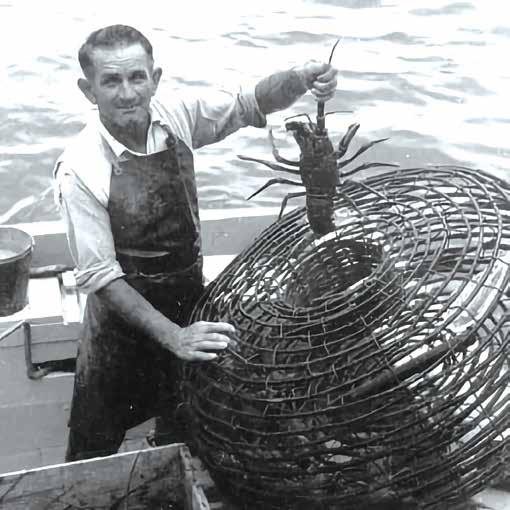
of the ‘hardness’ of the seabed and in time the most sophisticated and expensive paper sounders were more than paying for themselves because fishermen could set pots where they had

operating in the most remote areas of the West Coast. Innovation came in the form of freezers being installed on their boats so that lobster tails could be held at -16 degrees
1980’s. In fact, before the roll out of the Quota Management System (QMS) in the mid-1980’s, most if not all rock lobster fishermen right around the New Zealand coastline would likely have considered themselves to be diversified inshore fishermen, with a seasonal portfolio of fishing methods and target fisheries. Quota reductions for most finfish species in 1986 forced greater reliance on lobsters for their annual income.
One aspect of lobster fishing always under review is gear design. From the 1960’s to the late 1970’s fishermen were quickly making the transition from the old-style lightweight ‘beehive’ pots to the more durable steel welded mesh ‘cages.’ Round beehive pots moved in a big swell, often twisting across the seabed and winding the ropes and floats under, never to be retrieved again. On the Wairarapa coast in the early 1970’s it was not unusual for the beach launched boats to work up to 150 pots in a day. One big southerly storm could wipe out half of those overnight.
More innovation was applied to making pots more durable. Rust was the enemy and various treatments were applied over the years. The old-style tar pit treatment was widely used, where old and new pots were submerged in boiling tar – often perked from the surplus disposed of by roading contractors – and hung to dry. It was a dirty, messy job and it was only reasonably e ective, other than many fishermen believed that tarred pots caught better than raw steel ones. The most e ective gear innovation was galvanising or the use of sacrificial anodes on steel pots.
Those were definite rust beaters and lengthened the working life of pots and reduced the number of replacements required each season, but pot loss in storms was still an issue so the gear started to become progressively heavier and often larger. A standard steel welded mesh pot in 1971 was #8 gauge wire and about three foot square standing 14 to 18 inches high with a dab of concrete, maybe a couple of sash weights or a few chain plates fixed to the base.
Within a few years, mesh was built from heavier #6 gauge wire and pots were fitted with a house brick wired into each of the four corners or steel bars welded across the base. It did not take too long for fishermen to figure out the concept of ‘pots for spots’ and whilst the smaller
gear was deployed in shallow water, larger and heavier gear started to show up in the form of one metre square mesh pots with multiple entrances and steel welded frames covered with trawl mesh or similar laced on with stainless steel wire. Such pots are still in common use.
Heavier gear required heavier lifting tackle. In the developmental years of the lobster fisheries, it was not uncommon for pots to be pulled by hand. Early mechanical winches on small boats were Heath-Robinson a airs often using the gear box units of old wringer washing machines with power supplied by small lawnmower engines. The gear boxes were fitted with small surge drums, and it was a skilful fisherman who could slip the pot rope on a surge drum

to prevent the small boat tipping over if a jammed pot was encountered.
The larger boats with inboard engines opened the world

Between 2002 and 2011 the Waikato region treasured having The Boat, Fishing and Leisure Show, which at its peak attracted around 23,000 attendees! For 12 years now the region has not had the privilege of enjoying such an event. After many requests we are very excited to bring the region its very own boat show once again in the form of......The NZ Boat, Fish and Dive Expo which will be held on the 31st August - 1st September 2024 at Mystery Creek

in overseas fisheries. The first hydraulic power units on small vessels were power steering units (the 70’s series Holdens had a reputation for reliability) but purposebuilt hydraulics manufactured and marketed by Hamilton in Christchurch very quickly became the haulers of choice.
Events Centre, Hamilton!
If you are in any shape or form interested in any water based sports from boating to fishing, diving, spearfishing, kayaking, wakeboarding, skiing, jet skiing, seafood or the culinary preparation of it, then this is one event you cannot a ord to miss!
Get ready for an absolutely epic weekend celebration of all things on, in or under the water!!
Door Prize info
Buy a ticket to the NZ Boat, Fish & Dive Expo and go in the draw to WIN our awesome door prize valued at $22,000!!!....An epic 7 day Fiordland Adventure for 4 people with the Get Wet Waikato crew onboard the vessel Legacy! A once in a lifetime trip filled with incredible diving, fishing, hunting, amazing scenery, scrumptious seafood dinners and of course lots of laughs and good times! *Some t's & c's apply.
of hydraulics and somewhere along the timeline of the 1970’s, fishermen also discovered the alloy or steel plate line haulers and rope ‘peelers’ used
By the mid-1980’s operators had greatly improved the e ciency of catching lobsters and achieved some reduction of operating costs. The challenge was then with processors and exporters to increase the value of the product. There was one small processor willing to meet the challenge. From a small fishing village on the South Wairarapa coastline, a company named Ngawi Packers, owned by a consortium of three local fishermen and a Wellington fish retailer, opened the live lobster market to Japan. Within three years the lobster industry had reduced its dependency on the otherwise static US tail market and was building on the lucrative Asian live lobster market pioneered by Ngawi Packers.
Just in time too. The economic performance of the lobster industry had been in decline before the QMS and the live lobster market was a significant bu er at the time and has turned out to be an enduring one. In the next episode: - Investment and strategic planning; consolidating the long-term sustainable utilisation of New Zealand lobster fisheries.
Come and make a splash!
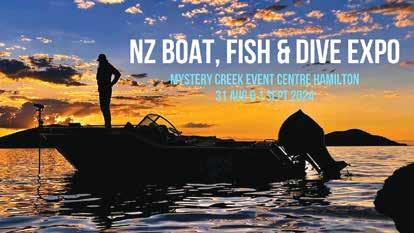
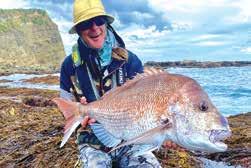

TICKETS
Adult 1x Day Pass - $25.00
Children 14 & under - Free Saturday 9am - 5pm & Sunday 9am - 4pm
Scan here for ticket purchase

The recreational daily catch limit for kina around the northeastern North Island is being increased from 1 August 2024, to help address kina barrens.
The new daily limit will be 150 and applies from North Cape in Northland to Cape Runaway in the Bay of Plenty.
special permit to allow people or organisations to harvest, cull, or move kina to help habitat restoration or to prevent these bare kina spots developing.
Both the daily limit and special permit apply to long-spined sea urchins as well as kina.

Kina barrens are areas of rocky reef where healthy kelp forests have been consumed by an overpopulation of kina and long-spined sea urchins to form a barren space that is detrimental to other sea life.
There is also a new
Permits will go through an application process which will include providing evidence of a current or potential kina barren in the area before it is approved. Special permits can be applied for in any part of New Zealand.
Pāua theft, too many cockles, buying recreationally caught fish, and other shellfish o ences result in big fines. People failing to follow shellfish gathering rules, along with fishing in closed areas and buying recreationally caught fish has cost some fishers thousands of dollars in fines.
“There are consequences for failing to follow fishery rules and for some people, it will hurt their wallet. Our job is to protect fishing resources so that everyone can enjoy the opportunity to put fresh kaimoana on the dinner table,” says Fisheries New Zealand Director of Fisheries Compliance, Steve Ham.
A 26-year-old Taranaki man was fined $800 in the Hawera District Court for taking pāua from a closed area. In August last year, a Fishery O cer received a call on the poacher line

about a man taking pāua from the reef at Manihi Road which is within the Western Taranaki closure area. The man had 23 pāua and had previously been spoken to by Fishery O cers about the shellfish closure.
man was fined $800 in the Wairoa District Court for refusing an inspection of his catch by a Police constable at the boat ramp in December 2021. Under the Fisheries Act, Police also hold the power of a Fishery O cer, and the
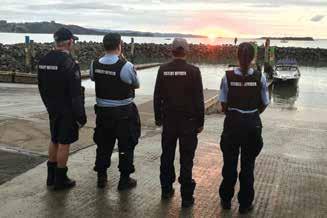
A group of three Timaru fishers aged between 27 and 48 were each fined $750 for taking a total of 64 pāua from the Mutu Mutu Point area of which 63 were undersize. The area is within the Tuhawaiki Mātaitai reserve where a bylaw allows fishers to take three pāua each per day.
A 52-year-old Māhia
constable could see at least two fish bins on board that appeared to be filled with crayfish. A Canterbury pair aged 38 and 53 were fined $900 each in the Christchurch District Court for being in possession of 677 Cat’s eyes. The pair were fishing with two children and the four of them were entitled to 200 Cat’s eyes (50
each), so they had over three times the daily limit. The group were stopped and catch inspected by an Honorary Fishery O cer in November 2023.
A 56-year-old Auckland man was fined $2600 in the North Shore District Court for buying fish that was caught illegally.
“If you’re unsure of the fishing rules in the area you plan to fish – get the most up to date fishing rules by downloading the free NZ Fishing Rules mobile app. It will also work if you’re fishing in an area with limited mobile coverage,” says Fisheries New Zealand Director of Fisheries Compliance Steve Ham.
Fisheries New Zealand encourages people to report any suspected illegal fishing activity through the Ministry for Primary Industries’ 0800 4 POACHER line (0800 47 62 24).
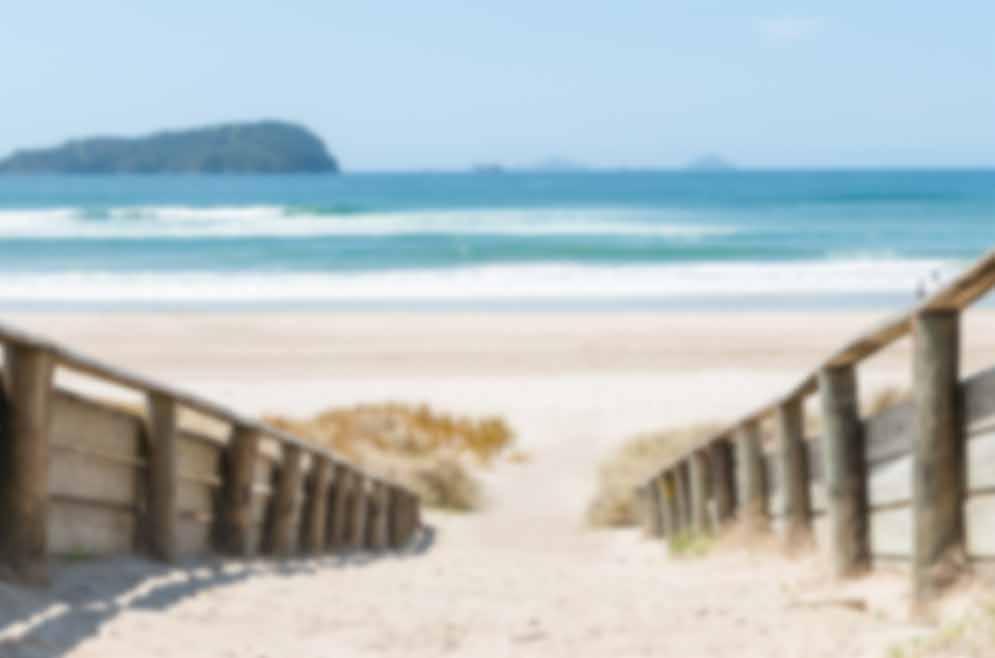
Recreational fishing is a popular activity in New Zealand and other coastal nations. Each year, sizeable portions of any nation’s population fish to catch a feed or simply relax and unwind outdoors.
New Zealand’s recreational fishers must share fisheries resources with commercial and customary fishing interests. Each interest desires similar outcomes regarding adequate access to sustainable, abundant fisheries now and in the future.
However, tensions and conflicts can occur whenever access is impaired and resource
Randall Bess
abundance is compromised; a potential notable cause being Government and public interest in increased marine protection (e.g., Otago and Catlin coasts).
Fortunately, South Island fisheries are well known for the varied fishing interests working collaboratively towards shared outcomes. They realise that reliable and timely catch, e ort and catch location data is critical to improving the management of shared fisheries.
While data on commercial and customary catches must be reported, there is no requirement to report recreational catch
data. Obtaining estimates of recreational catches is inherently challenging.
Unlike New Zealand, some coastal nations obtain low-cost, reliable and timely recreational catch estimates because they have developed comprehensive databases, or registers, of those who participate in fishing.
Since New Zealand has not invested in a recreational fisher database, considerable time and money is expended just to find enough recreational fishers who are prepared to be involved in a year-long,
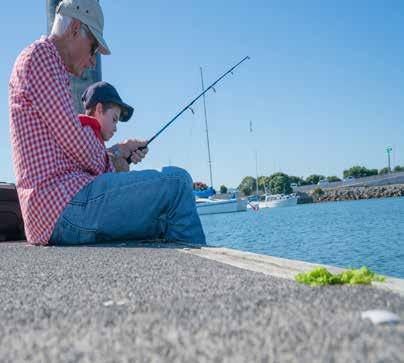

telephone-diary survey to collect data.
The primary method for collecting recreational data is the National Panel Survey (NPS). The NPS is householdbased, meaning that recreational fishers are found by randomly selecting households and eliciting survey participation in each household.
One downside to this methodology is that it is di cult to achieve the sample size required for accurate estimates of catch and e ort and at appropriate spatial scale.
For example, the NPS randomly selects
and contacts households until there are 5,000 to 7,000 participants in the survey, which equates to only 1% of the total estimated number of fishers.
In other words, data from 1% of fishers is extrapolated to estimate 100% of the catch by region and nationwide; this methodology is inherently problematic due to the small sample size and resulting inaccuracies and untimely estimates (the NPS is undertaken every 5 to 6 years due to its high cost).
Nonetheless, the NPS remains the primary data collection methodology,


which costs $5 to $6 million per survey, and most of these funds are spent finding randomly selected households with a willing survey
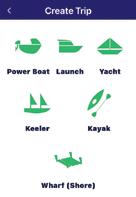
participant.
Another downside is that the NPS’ catch estimates are less accurate because household-based surveys cannot account for transient fishers.
Several South Island regions have at-risk fisheries that are exposed to significant recreational e ort by those who live in other regions.
Fish Mainland considers the best long-term solution is the use of a comprehensive database of those who participate in recreational fishing.
That way, more frequent and lowercost surveys can be undertaken that provide more reliable and timelier (seasonal)
recreational catch estimates at various management scales (e.g., paua QMAs, blue cod zones, mataitai reserves, etc.).
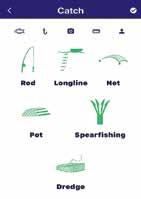
The muchneeded database is already in place because of South Island fishers using the Mainland Catch app. Fish Mainland recently developed the app with the expertise of Fisheries New Zealand and the financial support of the Sustainable Food & Fibre Futures fund (MPI).
And the easyto-use Mainland Catch app, along with its database capability, has been developed for a fraction of the cost of a single NPS.
So, the best solution for improved fisheries management is ready and waiting for Fisheries New Zealand to publicly promote its use.
Longlines have always fascinated me since I was younger, walking along the beach and watching someone set a kontiki was always exciting. You never know what could pop up when they bring it in. Beach activities were had and then once the winch began to reel in the line, I remember rushing over to get a glimpse of what was on the end of the line.
In the present day, I am lucky enough to make use of my uncle’s (Marty Cooke) manual long-line and have been learning how to set and pull it in through the use of a kayak. There is no luxury of electric winches or kontiki to get it out there but in some ways, this makes the fish feel much more earned when you do have a good set. But the aching arms from winding the crank and paddling does make me think twice. A typical set starts with preparing a range of tough baits like salted tuna, slimy mackerel and kahawai. These are all favourites due to their tough skin
which helps to hold onto the hook on the trip through the surf. On recent occasions I have combined this with a crab flavoured fish bite for an extra shellfish attractant to cover other species like blue moki and spotted dogfish. Once all of the circle hooks are baited, I attach the clip to the rear of the kayak along with a sinker and begin the mission through the surf. Usually, I try to set when the weather is relatively calm to avoid being caught up in the line if I get bowled over by a large wave. As the line goes out, one of the team on shore begin to clip the hooks to each section through the use of shark clips. It’s important to spread these out to avoid tangles and also to cover more water. At the midpoint of the set after 12 hooks are attached, we place a sinker and finally once all 25 of the hooks are attached another sinker is placed to anchor the rest of the line to the bottom where the fish are likely to be feeding.
Back out at sea I do my best to paddle the heavy line out to around 1 kilometre o shore before disconnecting and dropping the front sinker. I return to shore and relax for around 40 minutes before the retrieval begins.
In calm weather fish that can be expected are gurnard, kahawai, snapper, blue moki, spotted dogfish and many others who like to feed just outside the surf break.
The fence reel is usually shared between a few people as winding in a kilometre of line is not the easiest task on one pair of arms. As the first sinker reaches the beach, its excitement levels to 100 percent as usually the first catch is not far behind. There’s a gurnard! And another! On this day the fish just didn’t seem to end with a line full of seven gurnard and a few large kahawai mixed in. Not bad for a few hours sat on the beach!
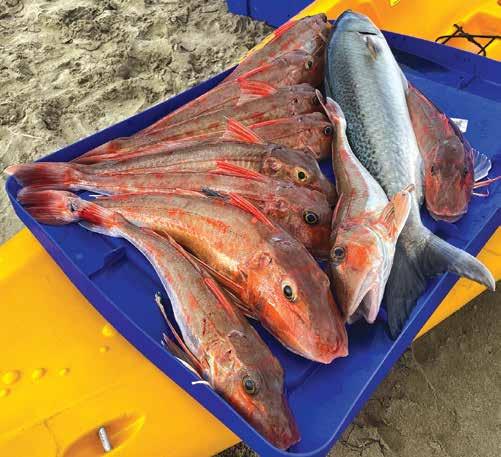
Blair Whiting
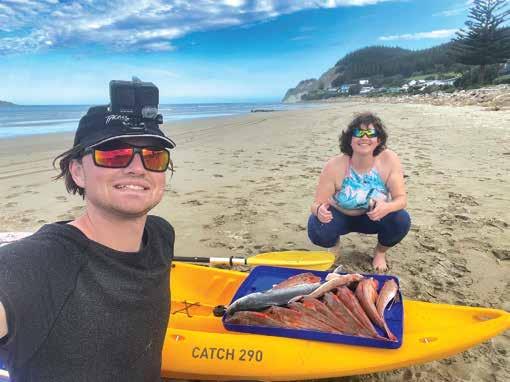
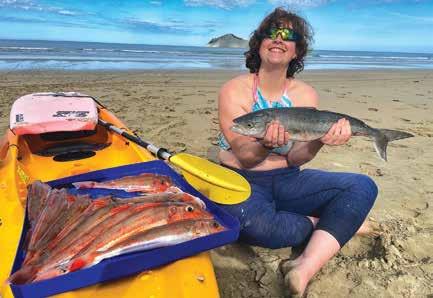



•
• Aeroo Drone
• Demos
• Drone Tutorials
• Surfcasting Tutorials
• Guided Fishing Trips
• Prices on application
•


WE SPECIALISE IN HOSTING FISHING TOURS FOR GROUPS OF TWO TO SIX PEOPLE ALONG THE SPECTACULAR, RUGGED COASTLINE OF KAIKOURA, NEW ZEALAND
Join
you have a memorable fishing experience while visiting Kaikoura. Also available Freediving trips - Take a kid fishing Ladies trips - Game fishing for Sharks CALL AND BOOK A TRIP TODAY Mobile: +64 21 843 908 Email: info@topcatchcharters.co.nz

